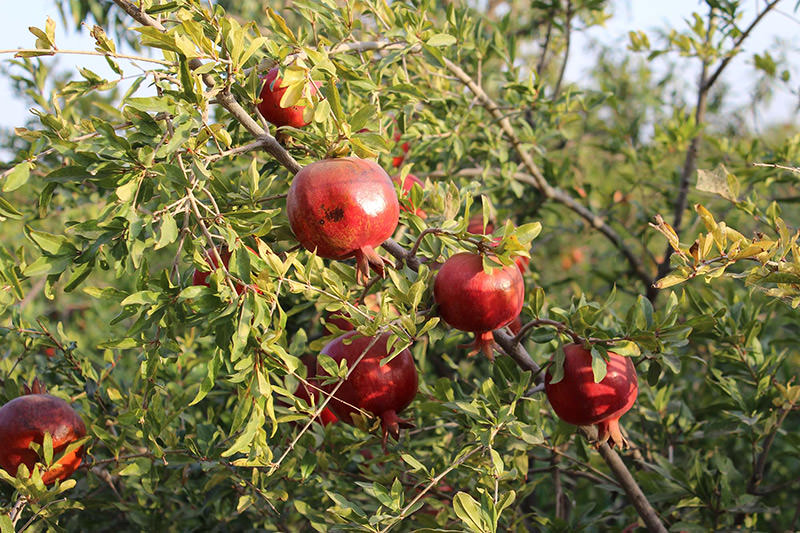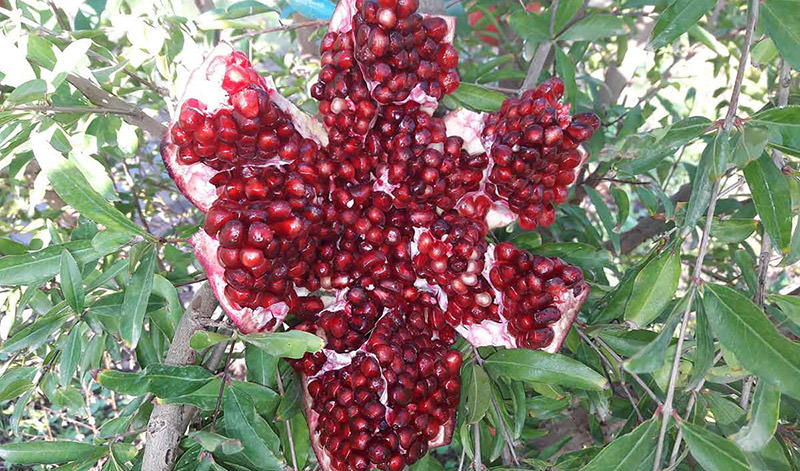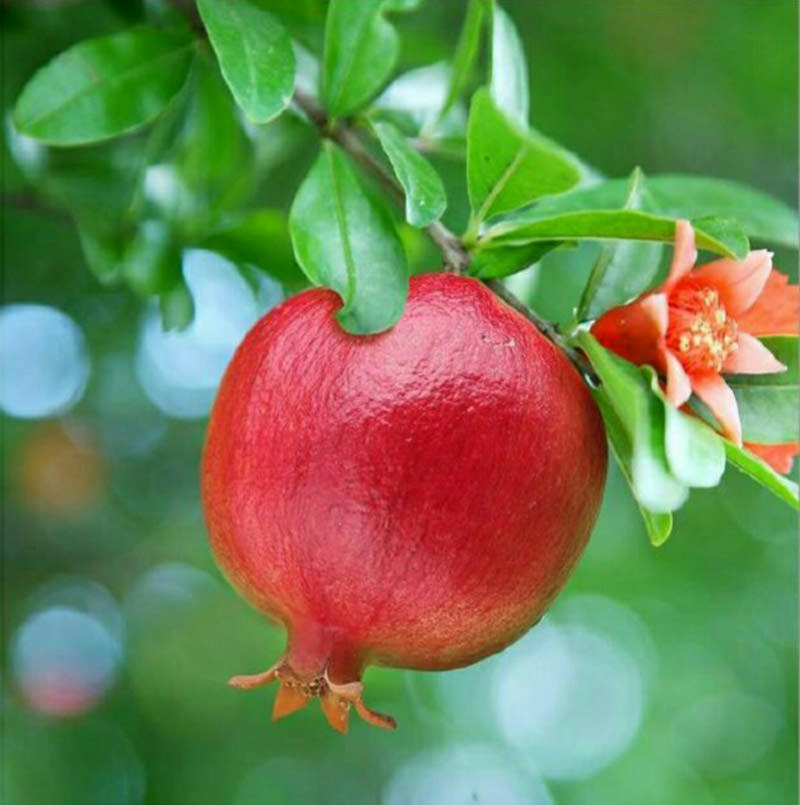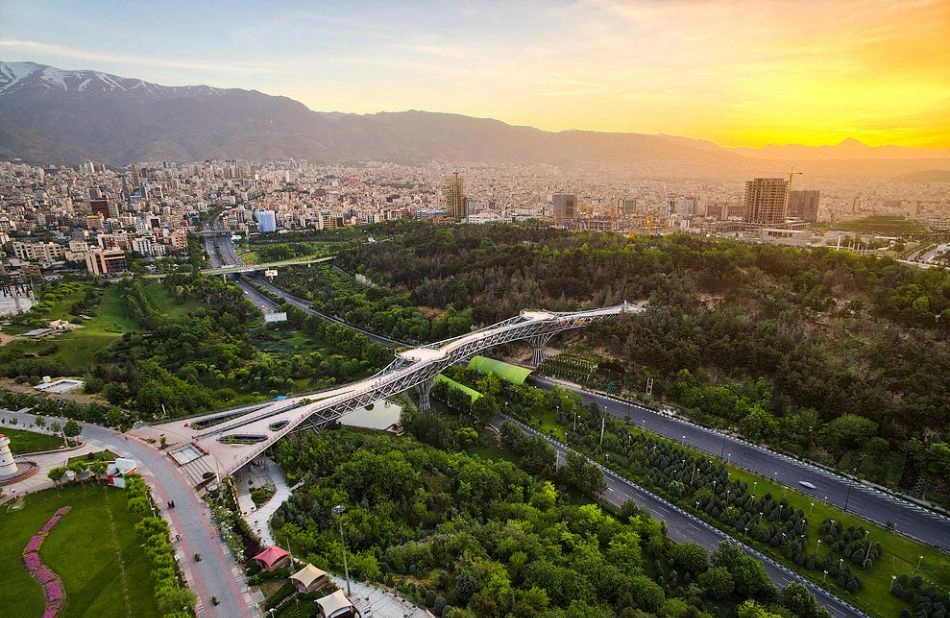Anar Saweh; Lovely autumn
Autumn marks the arrival of red, tart, and sweet pomegranate seeds. The city of Saveh is renowned for having the most famous pomegranates globally, as mentioned in the travelogues of tourists and explorers.
What is the souvenir of Saveh?
Saveh is a city of autumnal ruby gems, boasting the world’s most famous pomegranates. Even some travelers and globetrotters have noted it in their travelogues. During the fall season, alongside exploring Saveh, you can obtain this autumnal fruit and its related products.
Pomegranate
Pomegranate is a native fruit of Iran.
In Arabic, it is called “Nar,” “Golnar,” “Ruman,” and various other names. The word “pomegranate” is likely related to non-Aryan languages, similar to “fig” and “grape.” Pomegranate is native from Iran to the Himalayan mountains in northern India. It is grown in countries such as Iran, Afghanistan, Pakistan, Iraq, Turkey, Italy, Spain, Portugal, Greece, and semi-tropical regions of the Americas. In Iran, it is cultivated in cities such as Saveh, Qom, Kashan, Semnan, Gorgan, Kohnouj, Varamin, Yazd, Kerman, southern Khorasan, Fars, and Baluchistan. Iran, with 6,500 hectares of cultivated pomegranate trees, not only has the most exquisite pomegranates but also the highest quantity of production globally.

This fruit is one of the oldest known to humanity and existed in the wild before the advent of agriculture. According to archaeological evidence, pomegranates have been traced back to the 4th and 3rd millennia BCE, with indications of their cultivation in the hanging gardens of Babylon in Mesopotamia, present-day Iraq. During the Cartaginian or Punic Wars, pomegranates found their way to Italy and later, Muslim Moors introduced them to Spain. Subsequently, in the 18th century, the Spanish brought this fruit to California. In 1518, King Henry VIII established the Royal College of Physicians in England and chose the pomegranate as its emblem; in fact, “Pomegranate” was the family name of Henry’s Spanish wife, Catherine of Aragon, who planted the first pomegranate tree in England.
Pomegranate in Iranian Culture
In Persian culture and mythology, the pomegranate symbolizes abundance, fertility, and eternity, often associated with the feminine. In some narratives, it is mentioned that Esfandiyar, a Kianian prince, became invulnerable after consuming pomegranates, and the blood of Siavash, a mythical figure, gave rise to the growth of a plant called Siavashan, identified as the pomegranate. In Iranian mythology, Farhad, upon hearing the news of Shirin’s death, struck his own chest with a pickaxe, and where his blood spilled on the ground, a pomegranate tree sprouted.
The famous Persian poet Ferdowsi has also celebrated the pomegranate in his verses. In Iranian culture, the pomegranate is a symbol of prosperity and is believed to have various benefits. The ancient Greeks and Romans mentioned the cultivation of pomegranate trees during the Achaemenid era. Plutarch referred to a gift of a pomegranate to King Artaxerxes I. Golden pomegranate-shaped earrings dating back to the Achaemenid period were discovered in Kurdistan and are now housed in the National Museum of Iran. Additionally, prominent reliefs from this period, such as those in Persepolis, feature motifs resembling pomegranates.
In the third millennium BCE, a clay tablet with a decorative circle containing a pomegranate motif was discovered. From the Achaemenid era onwards, gold pomegranate-shaped earrings were found in Kurdistan and are now preserved in the National Museum of Iran. During the Parthian and Sassanian periods, pomegranates continued to be represented in art and architecture, evident in plasterwork and reliefs that have survived.
Pomegranate in Various Religions
In the Quran, pomegranate is mentioned three times, notably in Surah Ar-Rahman, verse 68, where it is referred to as a heavenly fruit alongside dates and palms. In Zoroastrianism, during wedding ceremonies, a sweet pomegranate is split into two halves, symbolizing abundance, and each half is given to the bride and groom as a sign of fertility. Ancient Egyptians believed that placing a pomegranate with the deceased would bring hope for resurrection. Pomegranate is also present in Jewish culture as a symbol of fertility, good behavior, and prosperity, considered one of the seven species with which the Holy Land is blessed. According to Jewish tradition, each pomegranate has 613 seeds, representing the 613 commandments. In Christianity, pomegranate symbolizes eternal life and resurrection, and in Buddhism, it is one of the blessed fruits alongside lemon and peach.
Types of Pomegranates
The domesticated pomegranate tree is a small, shiny-leaved tree with red, orange, and trumpet-shaped flowers. The fruit’s diameter can reach up to 12 centimeters, with skin colors ranging from red, pink, light brown, black, dark brown, yellow, to cream. The tree thrives in warm and dry climates with alkaline, sandy loam soil. There are also decorative varieties suitable for pot planting. The fruit season spans late summer to early fall, and the harvesting period varies depending on the location and type of pomegranate, extending from late summer to autumn.
There are different varieties of pomegranates classified as sour, sweet, molasses-like, late-ripening, and early-ripening. Some prominent Iranian varieties include Shah-Chin, Rasemi, Khati, Khorma, Aqa Mohseni, and early-ripening pomegranates harvested until the end of Mehr (October).

Pomegranate in Saveh
Saveh’s pomegranates have been praised by travelers, historians, and writers. Notable figures such as Hamdollah Mostofi and Yakob Eduard Polak have mentioned the quality of Saveh’s pomegranates. Adam Olearius, a German ambassador to Iran in the 17th century, commended the lush gardens of Saveh with large pomegranate and almond trees. Even Nasser al-Din Shah’s personal physician, Jakob Eduard Polak, made note of Saveh’s pomegranates in his travelogue.
Pomegranate in Saveh
Currently, Saveh County has allocated 11,000 hectares to pomegranate orchards. Saveh’s pomegranates, including various types such as Yusefkhani, Tabrizi, Mohammadali Khani, Shirin Payizeh, Males, Alak, and Tareh, are renowned as the most exceptional pomegranates in Iran. Among them, the outstanding variety “Males” holds the highest export rates.
Harvesting; Pomegranate Picking
For the people of Saveh, autumn marks the season of harvesting the red jewels of pomegranates. The picking of this heavenly fruit begins in mid-Mehr month, keeping the orchard owners and villagers busy. Various pomegranate festivals are organized, celebrating the joyous occasion. If you visit Saveh during Mehr and Aban months, exploring the orchards and villages, you can easily procure this divine fruit and its related products, such as pomegranate paste and various sweet and sour snacks, directly from the orchard owners at reasonable prices. Additionally, you can capture enduring and beautiful memories of yourself and your family in the picturesque pomegranate orchards and other scenic places in Saveh.

Pomegranate Festival
An Indian proverb about the virtues of pomegranate states: “It cures a hundred diseases.” Hippocrates, the ancient Greek physician, used pomegranates for treating eye inflammations and regulating the digestive system, while Avicenna (Ibn Sina) highlighted the properties of its flower in his famous Canon of Medicine. Pomegranate is rich in vitamins and minerals such as potassium and magnesium. Its water is beneficial for physical and mental strength, protecting the body against infections. Pomegranate cores mixed with barley are used for animal feed, its peel for dyeing, and its condensed juice for ink. In the past, the peel’s roots were used to expel digestive system worms, and the peel itself was used as fuel for heating baths. Generally, pomegranate is considered beneficial for blood purification, Alzheimer’s prevention, kidney diseases, and other health conditions.
Pomegranate in Persian Poetry
Persian poets often metaphorically liken lips, teeth, and the color of a beloved’s face to a pomegranate. They use the blooming of the pomegranate peel to symbolize the heart’s opening up and relate the reddened heart to the blossoming pomegranate peel.








